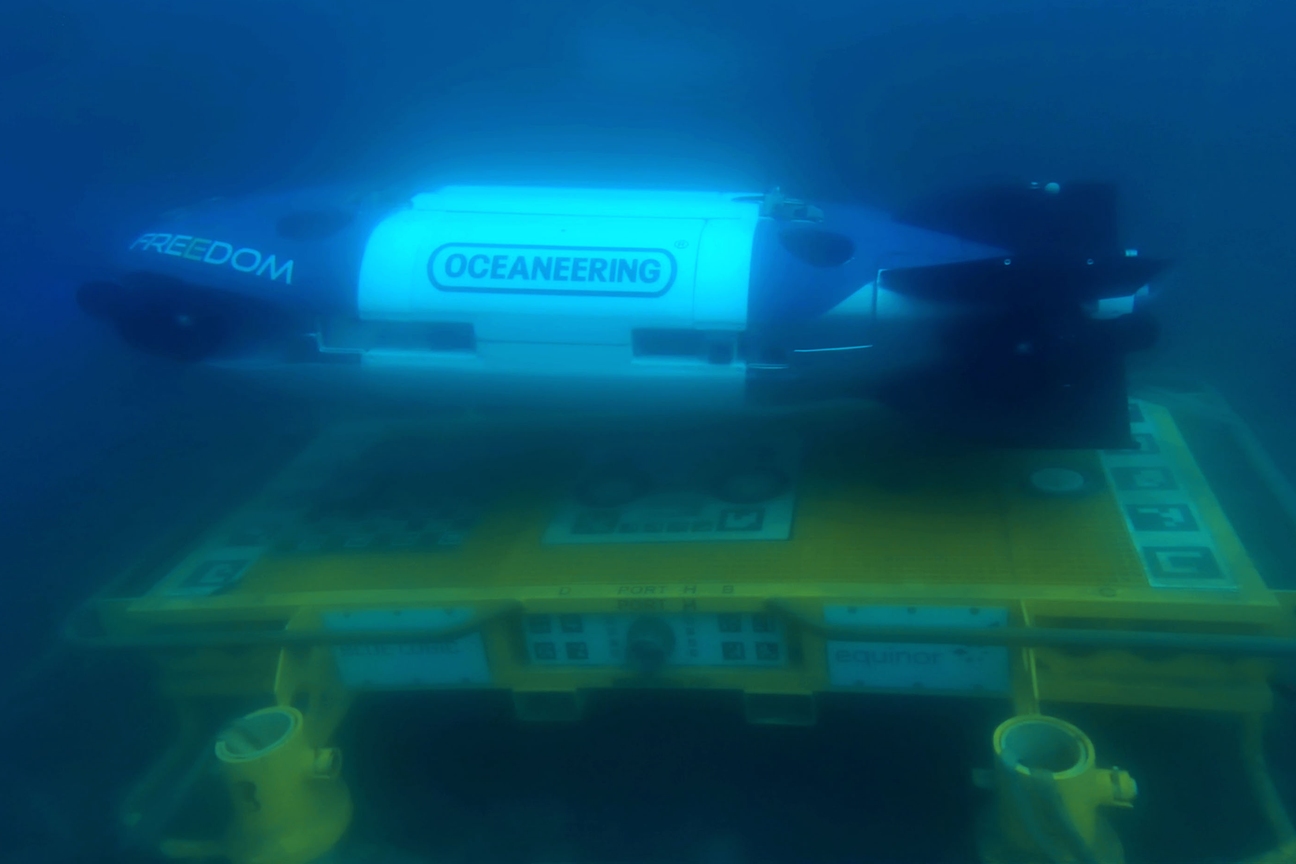
New Milestone for Freedom Drone™
The offshore energy industry has long required new underwater autonomous vehicles. Drones that could stay subsea for longer durations without the requirement of a support vessel. These vehicles could offer more flexibility, less frequent maintenance, and reduced health, safety, and environmental risks.
For over three years, Oceaneering has focused on the design, testing, and qualification of a new industryleading drone to supply those long-term operational functions–the Freedom™ autonomous subsea vehicle. All those hours of testing and qualification have led to a major breakthrough.

A new milestone
In September, the Freedom vehicle completed the industry’s first autonomous subsea docking operation using Equinor and Blue Logic’s new Underwater Intervention Drone (UID) docking station at our facility in Tau. The docking station was deployed from a quayside location. While in autonomous mode, the vehicle located the docking station and adjusted its orientation using integrated machine vision. This technology enables Freedom to analyze both heading and distance to ensure a perfect landing. Once docked, Freedom’s inductive connectors allow it to recharge its batteries, link to onshore locations to download data, and receive new mission information. Freedom has been put through rigorous design and
qualification testing at Tau, and this event marks a major accomplishment for the vehicle’s team.
The Freedom team has spent a considerable amount of time and effort developing the vehicle and the control software that powers operations. We are extremely happy with the success of the autonomous docking operation as this confirms that the technology is ready for the market. We have always been confident in our ability to engineer the solutions the industry requires and believe that this docking operation is a great result. We are thankful to Equinor for trusting our engineering and enabling us to demonstrate the capability and readiness of the Freedom vehicle.
Freedom’s Busy Year
It has been a very active year for Oceaneering’s Freedom vehicle and its engineering team. There have been many milestones achieved since the vehicle arrived in Tau in January, including adding the most compact and high capacity batteries yet seen for any subsea vehicle. The perk of having a team based in both the U.S. and Norway is that we can run near-round-the-clock development testing and verification. Once our U.S. software team starts their day, they effectively have a full day’s testing available to dig into and improve their code. This process has enabled us to greatly accelerate our software development and verification. Through August and September, the Freedom vehicle underwent numerous tests using the vehicle’s battery power while in untethered mode. We are now at Technology Readiness Level (TRL) 5 for the vehicle and software.
The next step for the development is to prove out the technology on real live assets in the North Sea. Here, we will mobilize a vessel and in close collaboration with three of our closest customers, we will put the vehicle through its paces on several subsea assets, both on the U.K. and Norway side. This will ultimately allow us to document a TRL6 level for the technology and ensure that the vehicle performs safe, efficient and high-quality surveys.

Looking Toward the Future
For the last several years, we have focused on pipeline inspection and pipeline survey as the primary work scope for the Freedom vehicle. However, beyond that scope, the technology roadmap and strategy for the Freedom technology is very exciting. As soon as the team returns from a successful offshore trial, focus will turn to expanding the vehicle’s sensor payload and range by building a new survey nose for the vehicle that allows for a very efficient geophysical survey machine.
The core technology is a modular concept where all components have been designed with long term residency in mind. Currently, we are developing a revolutionary tooling capability for subsea drones that will allow the vehicle to utilize a local resident tooling spread across multiple assets, much more reliably and efficiently than ever before. With artificial intelligence, you can program a mission and a scenario, and the vehicle can ask the pilot to verify the action that needs to be taken. This functionality means that someday we may not need to monitor the vehicle operations 24/7, but the vehicle can ask an SME to approve its decision-making process.
Marked Ready in November
We have made tremendous progress in the 16 years since Oceaneering introduced remote piloting to the industry. We now see bigger technological advances and a new way of thinking about how we conduct subsea operations. While Freedom may not totally replace work class ROVs, this kind of technology can provide flexibility and cost-efficiency. Work class ROVs must be maintained and usually come with crew in order to do so. Freedom was designed specifically to reduce the need for frequent system maintenance.
Technology adoption in any industry is slow, and in ours, it rightly should be. The consequence of failure drives the speed of introducing new technology. That is why, by the end of November, we will have completed almost two years of in water testing of the technology before we consider it ready for the market.
| 2017 | Freedom Project Begins |
| May 2019 | Commencement of the Living Lab Software Qualifications |
| January 2020 | Freedom Vehicle in the Living Lab |
| June 2020 | Freedom in Living Lab Untethered with Batteries |
| August 2020 | Freedom Undergoing Software Reliability Qualification |
| September 2020 | Successful Third-Party Docking Station Operation |
| October 2020 | Offshore Trials |
| December 2020 | Freedom in Operation |